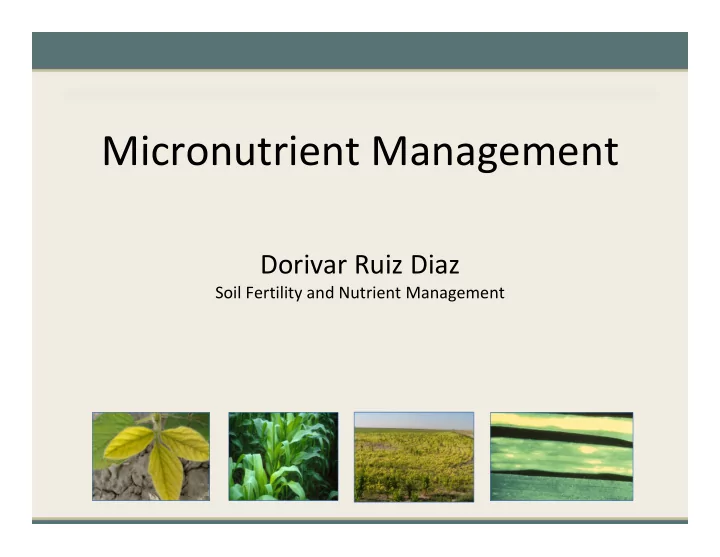

Micronutrient Management Dorivar Ruiz Diaz Soil Fertility and Nutrient Management
Essential Nutrients � Thirteen essential nutrients – Nitrogen, phosphorus, potassium, calcium, magnesium, sulfur – Iron, manganese, boron, molybdenum, copper, zinc, and chlorine •Nickel has recently been added � By definition, micronutrients are needed in small amount to achieve optimun plant growth.
Essential Micronutrients � Minor elements or trace elements � Increased interest in micronutrients – Higher crop yields and micronutrient removal rates – Declining soil organic matter, a major source of most micronutrients – N, P and K fertilizers contain lower amounts of micronutrient impurities � Excessive levels can cause toxic effects on plants � In Kansas: Fe, S, Zn, and Cl. � Other micronutrients: B, Mg, Cu, Mn, and Ni.
Total Micronutrient Levels in the Soil Surface Micronutrient Lb/Acre Iron 70,000 Manganese 1,000 Boron 40 Chlorine 20 Zinc 20 Copper 10 Molybdenum 2
Organic Matter � Important source of most micronutrients. � Simple organic compounds as chelates. � S, Zn and B deficiencies are more likely to occur in soils low in O.M. � Deficiencies of Cu and Mn are most common in peat soils.
Soil pH and micronutrient availability � Soil pH affects availability of micronutrients. � In general the solubility and availability of micronutrients are greatest in acid soils and lowest in high pH calcareous soils. � Exception is Mo. � In some soils, high levels of soluble Fe, Al and Mn may be toxic to plants.
Iron (Fe) � Iron in the plant – Catalyst in the production of chlorophyll – Involved with several enzyme systems � Deficiency symptoms – Yellow to white leaf color – Symptoms first appear on the younger leaves – Wide range of susceptibility of different crops • Sorghum, field beans and soybeans are more sensitive than corn and alfalfa • Varieties differ within crops
Iron deficiency
Factors Affecting Iron Availability � High soil pH. � Soils with high salt and carbonate contents. � Cool, wet springs. � Poor soil drainage and aeration. � Susceptible crops/varieties. � High concentrations of nitrate ‐ N inhibit conversion of Fe +++ to Fe ++ , increasing severity of iron chlorosis.
Soybean Fe Study ‐ 2009 • Varieties (2): high and low IC tolerance. • Seed treatment: with and without 0.6 lb/acre of EDDHA Fe (6%). • Foliar treatments: – 0.1 lb/acre EDDHA Fe (6%) – 0.1 lb/acre HEDTA Fe (4.5%) – No foliar trt • 4 locations with 5 replications
Objectives • Evaluate fertilization strategies. • Determine soil parameters (diagnostic): – Fe, Mg, P, K, Ca, OM, OC, TN, pH, EC, Carbonates, nitrate ‐ N . • Determine “optimum” plant tissue level. • Evaluate possible interaction of parameters, both in soil and plant. – Possible Fe ‐ Mn interaction?
Effect of soil nitrate?
The nitrate theory • Iron is part of the chlorophyll molecule • Iron taken up as Fe+++ (ferric) • Iron in chlorophyll exists as Fe++ (ferrous) • High concentrations of nitrate ‐ nitrogen inhibit conversion of Fe+++ to Fe++ • Reduce nitrate in soybean plants with the use of a competition crop
Soybean seed treatment with Fe chelate
Seed treatment
Chlorophyll meter readings SPAD Values
Plant height at maturity Inches
Soybean yield: seed and foliar treatment Average Labels yield W/O Seed trt 36 6% Foliar 35 Bu/acre 4.5% Foliar 38 No 35 W seed trt 50 6% Foliar 47 4.5% Foliar 52 No 52 Var AG2906: Very Good IC tolerance
Soybean yield: seed and foliar treatment Average Bu/acre Labels yield W/O Seed trt 39 6% Foliar 40 4.5% Foliar 37 No 39 W/ seed trt 50 6% Foliar 52 4.5% Foliar 49 No 49 Var AG3205: Low IC tolerance
Are these yield values significantly different? Effect F Value Pr > F Significance Variety 2.11 0.1487 NS Seed trt 69.6 <.0001 S Foliar 0.05 0.9553 NS Var*Seedtrt 0.19 0.6616 NS Var*Foliar 2.1 0.1268 NS Seedtrt*Foliar 0.1 0.9004 NS Var*Seed*Foliar 0.27 0.7631 NS
Some soil parameters Soil Fe Soil pH EC Soil OM
Foliar Applications � Applications must be done before plants are severely damaged by chlorosis and may need to be repeated. � One of several iron chelates/complexes may be used. Economical benefit need to be evaluated. � Critical timing – By the first or second trifoliate leaf
Fertilizer Sources of Iron � Deficiencies occur more frequently than most other micronutrients in Kansas � Patchy or irregular appearance in the field � Success with iron fertilization is difficult – Difficulty in correcting Fe deficiency with soil ‐ applied fertilizer • Iron quickly converted to unavailable form.
Common Iron Fertilizers Fertilizer Source Fe (%) Iron Sulfate 19 ‐ 40 Iron Chelates 5 ‐ 12 Other Organics 5 ‐ 11 Manure ‐ best ??
Average animal manure micronutrient content of different animal sources Manure source Iron Manganese Boron Zinc Copper ‐‐‐‐‐‐‐‐‐‐‐‐‐‐‐‐‐ lb/wet ton ‐‐‐‐‐‐‐‐‐‐‐‐‐‐‐‐‐‐‐‐‐ Dairy solid 0.5 0.06 0.01 0.03 0.01 Swine solid 19.0 1.09 0.04 0.79 0.50 Poultry 3.0 0.61 0.08 0.48 0.66 ‐‐‐‐‐‐‐‐‐‐‐‐‐‐‐‐‐ lb/1000 gal ‐‐‐‐‐‐‐‐‐‐‐‐‐‐‐‐‐‐‐‐‐ Dairy liquid 0.9 0.11 0.03 0.11 0.12 Swine liquid 2.5 0.23 0.06 1.03 0.62
Manure/Biosolids as source of micronutrients � Biosolids/manure can be excellent sources of Fe and micronutrient nutrition for higher plants � Soils with application histories can show higher micronutrient availability levels than those receiving commercial fertilization. � Maintaining adequate soil pH for crop production should ensure good micronutrient availability.
Summary ‐ Fe � Fe deficiency potential can not be explained well by a single soil parameter. � Development of an “index” may be the best alternative. � Foliar treatment seems to increase the “greenness” effectively. But seed coating provides higher yield increases.
Summary – other micros � The ability to coat seed with micronutrient is a concept that deserve further investigation. � There is again a recent interest for foliar application of nutrients. � Increased interest for mixing micronutrients with fluid fertilizer for band application. � Several nutrients in each dry fertilizer granule uniform distribution of nutrients?
Questions? Dorivar Ruiz Diaz ruizdiaz@ksu.edu 785 ‐ 532 ‐ 6183 www.agronomy.ksu.edu/extension/
Recommend
More recommend